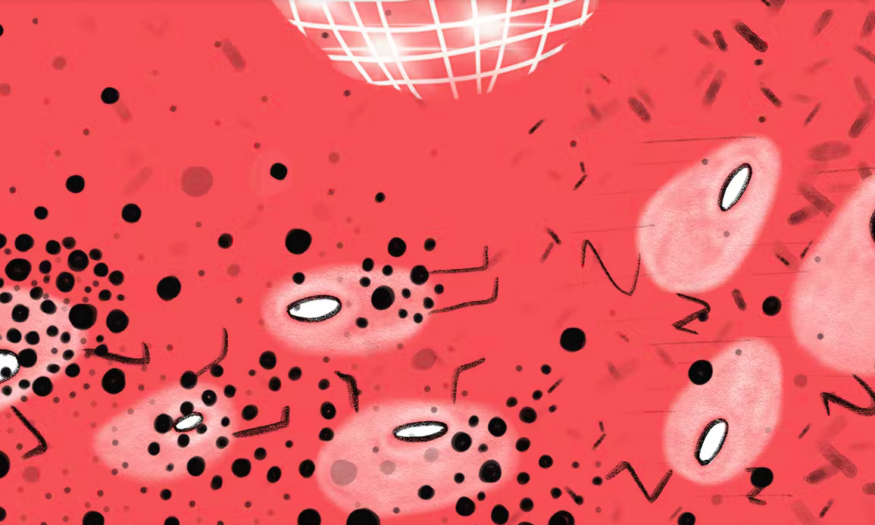What Exactly is a Hymen?
 Image by Natural Cycles
Image by Natural Cycles
-
Topics Include:
Genitals
Vagina
Vaginal Corona (Hymen)
Virginity
Vulva
by Our Bodies Ourselves Today
Revised December 2021
This content is adapted from an earlier article by Carol Roye.
What is the hymen and why is it important to so many of us? Common knowledge has it that the hymen is the difference between being a virgin and not being a virgin. But is “losing your virginity” the same as “losing” your hymen? And how do you lose your virginity anyway?
First of all, what is the hymen physically?
The vaginal corona—generally known as the hymen but renamed in 2009 by a Swedish sexual rights group in an attempt to dispel harmful myths about hymens—is made up of thin, elastic folds of mucous membrane located just inside the entrance to the vagina. While the function of the vaginal corona is unknown, it appears to be a remnant of fetal development.
Hymens come in many shapes and sizes. The mucous membrane that makes up the vaginal corona may be tightly or more loosely folded. It may be slightly pink, almost transparent, but if it is thicker, it may look a little paler or whitish regardless of your skin color. The vaginal corona may resemble the petals of a flower, or it may look like a jigsaw piece or a half-moon. It may be a scanty fringe of tissue, or even completely absent at birth.
The vaginal corona may tear or thin out during exercise, masturbation, or tampon use, or during other forms of vaginal penetration. Because of this, no one can look at or touch a vaginal corona and know whether a person has had vaginal intercourse, or even whether they have masturbated.
In rare cases, the hymen covers the entire vaginal opening. This is called an imperforate or microperforate hymen. Sometimes an imperforate hymen isn’t discovered until puberty, when a person experiences cramping and pain because the menstrual blood in their uterus can’t pass through the vaginal opening. In these cases, the hymen can be surgically opened so that the person can have regular periods, use tampons, and have other kinds of vaginal penetration.
Somewhat more commonly, a hymen band may be present across the vaginal opening, allowing menstruation but preventing tampon insertion. If the opening is very small or partially obstructed, minor surgery can correct this.
Hymen Ignorance
There is a lot of misinformation and many myths about the hymen.
Many people wrongly believe that the vaginal corona is a thick membrane that entirely covers the vaginal opening and ruptures the first time a person has intercourse or any kind of insertive vaginal sex. One myth goes like this: If a bride doesn’t bleed from a ruptured hymen on her wedding night, this means that she has had sex and isn’t a “virgin.” This is not true.
(We’ll come back to why people care so much about who is or isn’t a virgin.)
Most of us don’t know what our hymens look or looked like, how varied their appearance and dimensions are, and how little they comply with our cultural myths. Because of our lack of knowledge, we rely on stories that suggest hymens and virginity are some of the most important things about women.
In patriarchal societies, hymens have huge cultural significance. A hymen that is intact until marriage, and bleeds on the wedding night, is thought to demonstrate the woman’s sexual and moral “purity.” In reality, many women don’t bleed during first intercourse, either because their hymen has already been stretched or torn through other activities, or because it was very thin or flexible to begin with.
Learning about our hymens, and our bodies in general, can help us to feel more comfortable and in control in sexual situations. Unlearning the misinformation that we’ve been taught can help us better protect ourselves from STIs, as well as increase our sexual pleasure.
Virginity Testing
No medical exam on earth can tell if a woman or girl is a virgin. Unfortunately, parents, prospective in-laws, police, and even schools and employers still sometimes subject girls and women to coerced or forced “virginity testing.” In addition to being useless, virginity testing is harmful physically, psychologically, and socially. “From a human rights perspective virginity testing is a form of gender discrimination, as well as a violation of fundamental rights, and when carried out without consent, a form of sexual assault.” The use of virginity testing by police in cases of sexual assault is often paired with the sexist belief that if a woman isn’t a virgin, she “couldn’t” have been raped. While virginity testing may sound foreign, it happens in all regions of the world, including in the USA. The practice is so widespread, in fact, that UN Women, UN Human Rights, and the World Health Organization have called for a ban on its practice.
Purity and Virginity Pledges
Even in cultures where women’s sexuality is less severely policed, the sexist double standard often dominates. In the USA, for example, virginity is a multi-million dollar industry. Since the mid-1990s, the government has poured over $2 billion into “abstinence-only sex education” in a misguided belief that keeping young people ignorant about sexuality will keep them from becoming sexually active. The cultural valorization of virginity is also seen in the Virginity Movement: “Virginity Pledges,” “Purity Rings,” and other misguided attempts to maintain girls’ virginity.
Why Virginity?
But why is virginity considered such a big deal? Why are patriarchal and fundamentalist religious societies so intent on policing it? And why do we place so much importance on protecting it and “losing” it? Virginity is a religious and cultural construct, not a medical or scientific term. Our value as human beings should not be based on our sex lives, whatever our gender. The term virginity rests on sexist notions of sexual “modesty” and “purity,” which derive from grim histories of women treated as property, traded among men. In this patriarchal context, girls and women lose their value if they lose their prized virginity, a concept that is harmful to girls and women around the world. When our social value is based on virginity, parents and communities work hard to curtail our freedoms to protect it. Girls may be prevented from running, jumping, or riding horses to protect the hymen; girls’ and women’s activities may be tightly policed to prevent cross-sex mingling. This emphasis on virginity also sets up a “virgin/whore dichotomy,” in which sexually active women are rejected as bad, defiled, ruined, dangerous. The rejection takes many forms, including “slut shaming,” social ostracization, unmarriageability, rape justifications, and “honor killings.”
Hymen Surgery
One consequence of this obsession with women’s virginity is the booming global business in medically unnecessary hymen surgeries. Hymenoplasty, aka “hymen restoration surgery” or “revirgination,” alters a woman’s vagina so that it will be likely to bleed the next time she has intercourse. Typically, a thin layer of the inner vaginal wall is cut and reattached across the vaginal opening. This procedure, performed under local anesthesia, also reduces the size of the vaginal opening. The next time she has penetrative sex, the attachment will tear and cause bleeding.
Recovering from the surgery takes at least 15 days, and a person who undergoes it will need to take antibiotics and pain medication. In rare cases, hymenoplasty can cause recurring pain with penetration. The surgery is expensive and there is little information available about how many girls and women get the surgery each year, or about who is getting it.
The Hymen Renamed: Vaginal Corona
Because of the harmful and sexist treatment of this part of our bodies, a Swedish sexual rights group proposed a new term in 2006: the Vaginal Corona. “The mythical status of the hymen has caused far too much harm for far too long,” the Swedish Association for Sexuality Education (RFSU) said in a statement. Calling it a vaginal corona can empower parents, children, and communities to understand it as a normal body part with normal, healthy variation, rather than as a stand-in for personal and family morality. This part of our bodies is ours alone to enjoy, ignore, or share as we see fit.
Losing it
If virginity has no medical or scientific meaning, what is it really? It’s clearly a status with great cultural and social significance in most places in the world. But it’s also something that we can define for ourselves, or reject entirely. Because virginity has an emotional connotation, whatever virginity, or losing your virginity, means to you is valid.
Some of us believe that having oral or anal sex “counts” as losing our virginity. Some hold to penis-in-vagina intercourse as the only activity that removes virginity (a little problematic for lesbians, gay men, and other sexually active people who are then considered life-long virgins). Maybe we are virgins until our first orgasm in partnered sex. We may guard our virginity with our lives, or we may be dying to get rid of it. Perhaps we reject the idea of virginity all together. It’s especially important for sexual assault survivors to have the right to define virginity for ourselves. In any case, a person’s understanding of their own virginity should be respected, just like her understanding of her body and sexuality in other areas.
However we understand virginity, our worth as women and girls should never be based on the thin tissue of the vaginal corona. Now that you know what the hymen is, and is not, let’s work toward a world where women, girls, and gender-expansive people have the freedom to decide what to do with it.






